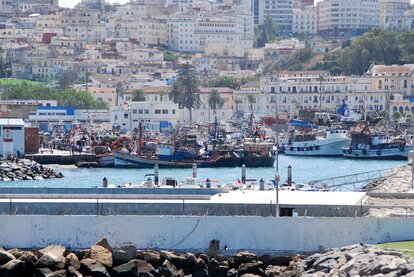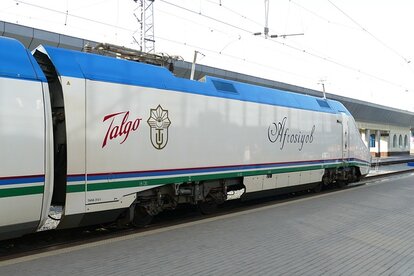Africa
Spain's view of North Africa

To say Africa is to say many words at once. It is to open a book with an infinite number of pages containing thousands and thousands of small, very different stories that clash with those that are blank, because there is still much to be written. Africa is a continent that is three times the size of Europe, where more than 2,000 languages are spoken, where nothing or very little has to do with the more than 1,300 inhabitants of the 54 countries that make it up, a population that is expected to increase to 2,500 by 2050. Africa is a mystery that is being unveiled or discovered little by little and where there are more and more interested glances.
That is why Africa today, without ignoring its armed conflicts, problems of famine, poverty or insecurity, because they are, whether we like it or not, a reality, is very different from what it was not so many years ago. Without losing sight of this unbalanced balance, both within the continent and when we look from one side of the Mediterranean to the other, the truth is that we can also see that a range of possibilities is opening up, and that, although at a different pace to others, some North African countries are committed to getting on this high-speed train. This continent is no longer looked to just to see how it can be helped, but also to analyse and jointly make the journey of progress it has signed up for. And Spain, for many reasons, including historical, geopolitical and geographical ones, does not want to miss out.
If we look at those African countries which, like ours, are bathed by the Mediterranean Sea immortalised in the paintings of the great Valencian painter Sorolla, we can affirm that Spanish businessmen are not wasting their time, as they are aware of its potential, a situation that is leading them to expand their trade relations and investments.
Let us not forget either the important role that Spain can and does play as a physical bridge not only from Europe to Africa, but also, mainly united by a common language, to Latin America. They know it; we know it. Let us remember, for example, the Global Gateway strategy that finances EU countries' infrastructures in Africa to the tune of 300 billion euros until 2027.

Tanger
© PixabayAnd in this regard we see Morocco, for which the European Union is its main trading partner, and within the member countries, Spain tops the ranking. The good relations between the Spanish and Moroccan governments are well known, which facilitates close cooperation in the area of investment and business activities. According to data from the Spanish Institute for Foreign Trade (ICEX), Morocco accounts for 50 % of Spanish exports to Africa, although it is not Spain that tops the list with 21 billion euros exported last year, but France with 60 billion, followed by Germany with 37.4 billion.
The same source points out that the sectors of products imported to the neighbouring country are mainly capital and consumer goods, with automotive and energy products standing out. In this sense, Morocco is promoting the arrival of investments. At the end of last year, the Investment Charter came into force, which sets out the main objectives in this area. The government has also launched programmes such as the 'Plan Maroc Vert' and the 'Stratégie Génération Green 2020-2030' for the agricultural sector.
Nevertheless, Spain is not at the top of the list of countries investing in Morocco, although it does occupy that position as a supplier to the Moroccan market. In 2021, 17,600 Spanish companies exported to Morocco, according to the Spanish Confederation of Business Organisations (CEOE). Moroccan companies affiliated to Spanish companies numbered 524. Automotive components, electrical equipment, fabrics and fuels are the main products exported by Spain.

Railway investments in Egypt
But in addition to Morocco, Spaniards look to Egypt, not only as a beautiful place to spend their holidays and relive one of the most powerful civilisations, with its mysterious pyramids and impressive history, but also as a place to invest. Not even a year ago, the Council of Ministers approved a loan to Egyptian National Railways and the Central Bank of Egypt for 200 million euros in order for Talgo to consolidate its position in the country. Investment in railway infrastructure is an interesting reality in this scenario of business opportunities, which also extends to the renewable energy and water treatment sectors.
In 2022, European countries were the main recipients of Egyptian exports, and Spain, as in the case of Morocco, together with other Mediterranean countries such as Italy and Greece topped the list. One of the main products shipped to Europe was hydrocarbons, which increased due to the war in Ukraine. However, it was precisely this war, after the pandemic, that served the Egyptian government as an excuse to apply restrictive trade measures.
According to an ICEX report, trade relations between Spain and Egypt are below their potential, although they grew last year due to exports of natural gas from the African country to Spain as a result of the war in Ukraine and the situation in Algeria. With respect to the EU, Spain went from being the 6th to the 4th supplier, behind Germany, Italy and France.
And if Morocco is Spain's leading market, Egypt is the second African market. There were 1,330 exporting companies in 2022 and 447 importing companies.

Gizeh Pyramids, Egypt
© PixabayThe Tunisian market
Tunisia is another of the North African countries that Spain is targeting. The European Union is this country's main export market, with France and Italy being the main destination markets, while Spain is in fourth place.
Tunisia's imports include petroleum and refined products, natural gas, machinery, electrical appliances and those related to the tourism sector; and exports of machinery and electrical appliances, clothing accessories, fuels and vegetable fats and oils.
Spain would not be among the main investing countries, a position occupied by France, Qatar and Italy. In 2022, Spain was its seventh largest supplier worldwide, with a market share of 4.1%, and its fourth largest customer, with a 4.5% share, according to the Tunisian National Institute of Statistics.
However, it should be noted that Tunisia is a priority partner for Spain, with whom relations are intensifying. Nor should we forget its tourist attraction, which makes it the second African country that received the most foreign tourists last year, with almost six and a half million, second only to Morocco.
Its neighbouring country, Libya, has significant oil and natural gas reserves. This fact makes the country a focus of attention, although it is true that the political instability and insecurity in the country cause significant mistrust. According to data from the Spanish Ministry of Foreign Affairs, European Union and Cooperation, in June of this year, a trade mission made up of ten Spanish companies travelled to Tripoli to exchange experiences and position these companies in the country. In 2021, according to the same sources, Spanish exports amounted to 310 million euros, 2% more than in 2020, highlighting products such as fuel, live animals, ceramics and automotive. The number of companies exporting to Libya was 330, 27% more than in 2020.
Africa has a part that we cannot forget. But this continent is also more than those memories that Robert Redford and Meryl Streep made half the world fall in love with. Africa is waking up and wants to bet, to move forward. Africa could be a butterfly that shows its colourful wings and starts to fly to attract the attention of many other countries and Spain... does not resist.
